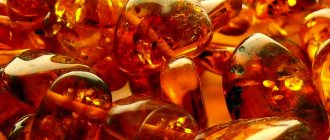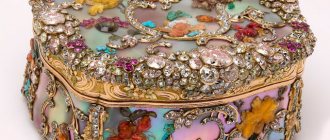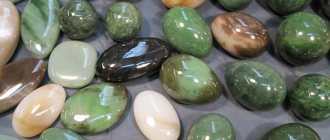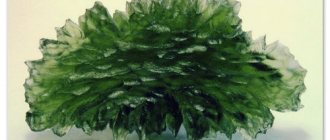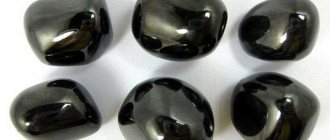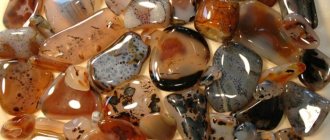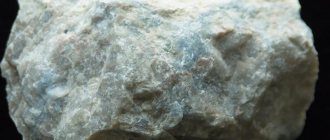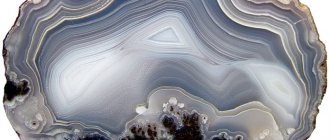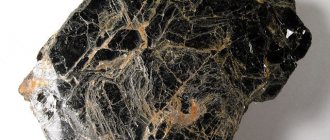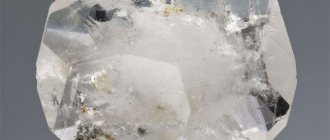History and origin
Cubic zirconia is a human creation and the triumph of technology in copying natural processes. The fate of the stone and its name is a plot for a detective story.
cubic zirconia
What is cubic zirconia
The crystals are obtained from zirconium dioxide. When processed, they almost copy a diamond in external and physical parameters, which is why in the Soviet Union artificial diamonds were called cubic zirconia.
There is a natural mineral of comparable qualities - tazheranite, found in the Tazheran Gorge near Lake Baikal. But its crystals are small, like jewelry, and are not used.
How it appeared
It was obtained artificially in the 1960s by physicists from the Lebedev Physical Institute of the Academy of Sciences. They called it by its first letters - FIANit.
Scientists experimented with a composition for the production of laser equipment, and the shiny material was considered defective production waste. Institute staff sorted the stones into souvenirs.
Enterprising citizens “helped.” Having brought the raw materials to marketable condition, they established sales to the West. At first they were delighted with the cheap “diamonds”. Then a scandal broke out and an investigation began. The traces led to the USSR.
The story was hushed up. The Europeans were uncomfortable with being fooled by the “backward Russians.” A limited circle of people in the Union knew about this, since the activities of FIAN were not advertised.
The party gave the task to scientists to create colored analogues of the stone for sale as jewelry. It was, of course, fulfilled; transparent multi-colored crystals at prices affordable for citizens filled jewelry stores. There was even a plan to release the stones.
Name confusion
The term “cubic zirconia” is used in the territory of the former USSR and Eastern Europe (former socialist countries). In the rest of the world, the material is known as zirconite, shelby, cubic zirconia, jevalite, and daimonsquay.
Sometimes cubic zirconia is called zircon or zirconium. But these are different things:
- cubic zirconia - synthetic, imitation diamond;
- zircon is an independent yellow-brown mineral;
- zirconium is a chemical element.
Misunderstandings arose because not everyone in the world wants to recognize the country's authorship. They also cannot forgive the embarrassment of half a century ago.
History of cubic zirconia stone
Cubic zirconia has several names.
Cubic zirconia is not considered precious because it is of artificial origin. To grow it, zirconium dioxide is needed. After special processing, it is not easy to distinguish it from diamonds. Both stones have a similar appearance. In addition, their physical characteristics also have a lot in common. For this reason, in the USSR, for a long period of time, cubic zirconia was called an artificial diamond.
This gem is also called “javalite”, “zirconite” and “daimonskvay”.
It is noteworthy that a stone with identical properties exists in nature. We are talking about tazheranite. It was discovered in the Tazheranskoe gorge near Baikal.
The technology for artificially creating minerals requires the availability of modern equipment. However, the price of such production is quite affordable. The cheapest specimens are represented by translucent, colorless and transparent stones. Colored cubic zirconias are a little more expensive. In order to imitate diamond placers, it is planned to use more complex technologies. Of course, the cost of such stones is higher. The price depends on the period of cultivation and cutting of the mineral.
Physicochemical characteristics
Cubic zirconia is an artificial material. The basic chemical formula of zirconium dioxide is changed by the components introduced during the synthesis of crystals.
cubic zirconia
The material is unstable, therefore it is supplemented with oxides of calcium, yttrium, and manganese. The structure of the crystal lattice and appearance resembles a diamond.
| Formula | Zr0.8Ca0.2O1.92 |
| Color | Yellow, orange, red, green, purple, pink, golden brown |
| Shine | Diamond |
| Transparency | Transparent |
| Hardness | 7,5—8,5 |
| Cleavage | Absent |
| Kink | Uneven |
| Density | 6.5-10 g/cm3 |
How are cubic zirconia produced?
Cubic zirconia is made in a laboratory. Scientists wanted to find a way to reduce the cost of devices that used diamonds, and the result was excellent. The stone turned out to be similar in characteristics to diamonds, sapphires, and amethysts. It can be painted any color. Thus, we found a formula for black cubic zirconia. It gets its color due to heat treatment.
The process of obtaining cubic zirconia is labor-intensive and complex. To do this, a number of chemical and thermal treatments are carried out in the laboratory. Cubic zirconia has high strength, hardness, shine, and is resistant to aggressive environments. The crystal grows quickly, which allows you to save on its cost. Cubic zirconia is produced in China, Thailand, Russia, USA, Switzerland.
Cubic zirconia obtained artificially after cutting is used as an insert for jewelry. The properties and characteristics of cubic zirconia allow it to be used in industry, medicine, optics, radio electronics, and steel production. It is used for the manufacture of optical instruments and scalpels.
Production
The stones are synthesized using high-frequency melting. Process description:
- The raw material (powdered zirconium oxide) is loaded into a container.
- A high-frequency generator supplies energy that melts the inside.
- Water circulating through the tubes prevents the temperature from rising above room temperature, so the outer layer of the substance remains cold and solid.
- The melt cools to room temperature.
- Columns 2 cm high and 2 cm in diameter are removed from the solid core.
The cycle is short: crystals grow by 8–10 mm per hour.
This is Soviet technology. It was invented by scientists, whom the state did not restrict in the use of resources. It is problematic for market conditions; even countries that bought it or received it from the USSR are simplifying production. But the resulting material is not cubic zirconia.
The cheapest are translucent, colorless or transparent crystals. Colored ones are more expensive: the external resemblance to precious gems is ensured by metal oxides and the subtleties of the process. The most expensive ones are multi-colored and imitation diamonds.
History of invention
The artificial stone owes its name to the Physical Institute of the Lebedev Academy of Sciences (FIAN), where it was created. Initially, the goal of the research was to obtain a material with certain optical properties necessary for laser equipment.
But already in the early 70s of the last century, cubic zirconia caused panic in foreign jewelry markets: a stone almost identical to a diamond cost a penny. In the 1990s alone, crystals with a total weight of 50,000,000 carats were produced worldwide. Since then, production rates have only increased.
Varieties and colors
The description of cubic zirconia always includes color.
The classic stone is colorless. It is not a problem for technologists to create an example of almost any color, including three-color cubic zirconia.
The shade of the stone is created by the base substance:
- yellow - copper;
Yellow cubic zirconia - brown - titanium;
Brown cubic zirconia - pink range - erbium;
Pink cubic zirconia - red gamma - neodymium;
Red cubic zirconia - green - chrome.
Green cubic zirconia
For blue shades, use cobalt or aluminum. A lavender color is obtained, which natural stones do not have. But imitation of emerald color for cubic zirconia is still unrealistic. The maximum is a resemblance to chrysolite in golden-green shades.
In jewelry, the crystal duplicates precious stones of the first or second row:
- blue - topazes;
- green - chrome diopside;
- yellow - citrine;
- golden - chrysolite;
- red - garnet or ruby;
- blue - sapphire;
- purple - amethyst;
- black - carbonado.
Stones change color in daylight and artificial light. Comparable in luster to alexandrites, transparent yellow, green or brown samples become black or white after heat treatment.
Applications of stone
Today, when describing cubic zirconia, we can say that it is the most popular, beautiful, artificially synthesized gemstone. Jewelers use it as an independent insert in silver, gold, and platinum products. But greater interest is shown in combined jewelry. The main assortment in jewelry stores consists of cubic zirconia jewelry of various sizes.
Cubic zirconia ceramics are produced using artificial crystals. For ophthalmology, inert implants and low-traumatic scalpels are produced, and for microelectronics, substrates are produced for obtaining conductor-on-dielectric structures. Ceramic tools are durable and lightweight. More recently, manufacturers in the technical industry have begun to produce ceramic cases for watches and bracelets. Craftsmen actively use cubic zirconia for their design projects.
After the invention of synthetic crystal, jewelers claim that buyer interest in natural diamonds has fallen. Thanks to technological processes, manufacturers are constantly expanding their range of artificial stones. Today, artificial minerals are also grown in industrial enterprises.
Medicinal properties
Cubic zirconia has a dual nature - a natural base and a “diamond” structure, but an instant, by nature’s standards, creation process. Its medicinal and magical properties give rise to controversy.
Lithotherapists who are fans of the stone believe that it heals the body. From it comes the energy accumulated by the base substance plus received during creation.
cubic zirconia
Contemplation of the stone improves mood, giving strength to recover from a nervous shock, serious illness or surgery.
Talismans and amulets
Cubic zirconia is of artificial origin; astrologers continue to study its magical powers. Inserts with cubic zirconia in pendants deserve special attention. Talismans and amulets mean good luck, happiness, family well-being, and also drive away negative energy from the owner of the magical instrument:
- Crystal matters to journalists.
- Helps indecisive people get rid of their complexes.
- It will give activity and confidence in actions to a modest person, and courage and determination to a timid person.
- Restrains emotional people from their actions.
The most common cubic zirconia talismans and amulets include: a horseshoe, a raking spoon, a horseshoe with a clover, a four-leaf clover and the Erzgamma star.
Magic properties
Esotericists have established the ability of a stone to return to its owner the emotions or energy received from it. Therefore, when communicating with cubic zirconia, you need to be positive.
The magic of the stone is consonant with a person of any age, gender or profession. But this is the patron saint of scientists and creative people. The properties of cubic zirconia are useful for those who want to do a lot at once: visit more countries, perform at several concerts or performances. A ring or pendant is suitable for a person who works with large amounts of information.
The magical mission of cubic zirconia is to bring joy. And how can you not be happy when you buy a stone that is indistinguishable from an elite diamond or ruby? Subconsciously, the owner of the jewelry begins to believe in himself, set high goals and reach a new level of life.
The magical properties of the stone are useful for timid people with low self-esteem. Mercantile or impudent people are confident in his patronage. But it is advisable not to overdo it: the pebble will return unkind thoughts to the owner.
Magic powers
Esotericists, studying cubic zirconia, noted that this stone returns to a person the energy received from it. Therefore, when going shopping, it is advisable to be in a good mood or even on a bright streak of life’s path. Having been charged with positivity from its owner, cubic zirconia will return it to its owner at the right moment so that he can resist sadness or any negativity.
Important! Do not buy a gem secondhand, as it already contains the energy of the previous owner. If, after all, you did not get a new stone, you can clean it in spring water or by holding it over a fire flame.
The magic of the stone is aimed at people of creative professions, as well as those who want to embrace the immensity. Therefore, the gem is suitable for travelers, athletes or scientists. In addition, cubic zirconia amulets protect on the road, bring good luck, and promise well-being.
Also read: Magnesite - a talisman with an ancient history
Cubic zirconia also symbolizes family happiness, making it a desirable gift for newlyweds. Such a talisman will bring harmony to the home, protecting spouses from discord and resentment.
Speaking about magical properties, the color specialization of the stone also plays a role:
- Blue enhances the sixth sense and creativity.
- Black emphasizes the necessary qualities - business acumen, intelligence, confidence.
- Green softens character, gives harmony with oneself and nature.
- Colorless symbolizes honesty and openness.
- Blue stone is an attribute of purposeful people, as well as a symbol of modesty and virtue.
- Yellow patronizes vulnerable, sensitive natures, absorbing sorrows and disappointments.
Sensuality and romance went to pink cubic zirconia. These stones attract all eyes on the owner, impart positive emotions, making her more attractive.
Who is suitable according to their zodiac sign?
Any zodiac sign can use an artificial stone.
cubic zirconia
Astrologers say that the magical properties of colored cubic zirconia are distributed according to the elements:
- Water (Pisces, Cancer, Scorpio) - white or blue;
- Air (Gemini, Libra, Aquarius) - rich yellow;
- Earth (Taurus, Virgo, Capricorn) - green or black;
- Fire (Aries, Leo, Sagittarius) - red stones.
Crystals are recommended for Aries, who will reduce the degree of emotions and temper.
| Zodiac sign | Compatibility |
| Aries | +++ |
| Taurus | + |
| Twins | + |
| Cancer | + |
| a lion | + |
| Virgo | + |
| Scales | + |
| Scorpion | + |
| Sagittarius | + |
| Capricorn | + |
| Aquarius | + |
| Fish | + |
(“+++” – fits perfectly, “+” – can be worn, “-” – is strictly contraindicated)
Properties of cubic zirconia stone for zodiac signs
It is believed that cubic zirconia is suitable for any person. It does not distinguish people based on age, gender, nationality or professional characteristics. Astrologers claim that it returns to its owner the received emotions and energy. For this reason, cubic zirconia should be treated with caution. After all, he will certainly return all negative feelings to the person. As a result, his mood will deteriorate. He will lose his temper and get angry. If the owner of the stone, on the contrary, strives for positivity, his life will be filled with joyful events and harmony.
As astrologers note, the properties of the cubic zirconia stone have a tangible effect on the zodiac sign Aries. He becomes a real protector and extinguishes his impetuosity and incontinence.
For the influence of cubic zirconia to manifest itself, each zodiac sign should give preference to a certain color. For signs of the air element, specimens of blue and black shades are suitable, for water signs - yellow stones, and for earth signs - green gems.
Cubic zirconia promotes success and self-confidence. For watermarks, the most effective imitations are sapphire, pearl and emerald. Representatives of the element of fire should purchase ruby analogues. They will become not only an attractive decoration, but also a strong amulet.
Products with cubic zirconia add elegance and sophistication to every person.
Compatibility with other stones
According to the horoscope or energetically, an artificially created stone does not conflict with any gems.
Jewelry with cubic zirconia and other stones
Application area
Cubic zirconia was created for technical purposes; it is not a precious stone, but its main area of application is jewelry. From abroad, stones come as zircons or cubic zircons.
Jewelry
This is a godsend and salvation for jewelry lovers for whom diamonds are financially inaccessible. A high-quality diamond cut has a high lower part and an almost flat upper part. This kind of cubic zirconia is expensive and is produced in small batches.
Price
Jewelry brands and workshops purchase crystals in bulk. A package of one hundred medium-sized stones costs $10–15 (the price of an average quality diamond is up to $5 thousand per carat).
The cost of cubic zirconia in the shades “ruby”, “sapphire”, “blue topaz” is twice as expensive as the standard ones. A good quality stone of 1.95 carats, 7x5 mm, is valued at $5, that is, the price per gram is about $12.
The price of products is determined by the precious setting, not the stone.
Ring with red cubic zirconia
Gold (585th standard):
- engagement ring with cubic zirconia - up to $100–120;
- stud earrings – $45–75, dangling earrings – $220–350;
- pendant - from $20.
Silver (925 standard):
- ring – $25–75;
- pendant earrings – $150;
- pendant - from 10 $.
Buying stones as raw materials or without a setting is unprofitable: the finished product is 13–18% cheaper.
Prices allow you to purchase jewelry as a set. Even celebrities don’t shy away from this.
Who is it suitable for?
Wear jewelry with a stone at any time of the day. Silver ones are appropriate during the day and in the office, gold or platinum are attributes for formal, important or evening outings.
- Earrings or a pendant with pink cubic zirconia are suitable for a young girl.
- A multi-color crystal set in a brooch will soften the severity of a business suit.
- A signet made of white gold or platinum with a black stone is a worthy men's accessory. A brutal option is a steel frame.
The metal of the frame of an item determines whether it is a jewel or costume jewelry.
Ring with pink cubic zirconia
In the second case, the crystals are framed with cupronickel, jewelry alloy or steel. This is a youth option.
What to consider when choosing a product
The number and dimensions of stones create a varied effect:
- a single large cubic zirconia insert in the product emphasizes the sophistication of the image;
- a scattering of stones makes the decoration an original universal addition;
- in a product where a large gemstone plays the “first fiddle”, and small cubic zirconias complement it, the gemstone looks more expensive.
White cubic zirconia crystals can be combined with gold of any shade.
The stone looks advantageous in a rhodium-plated setting: its shine is enhanced and refined.
Confusion in terminology
The term “cubic zirconia” is used only in the CIS countries and Eastern Europe.
In the global jewelry community, other names are used to describe the insert in a product:
- jewellite;
- zirconite;
- daimonsquay.
Cubic zirconia is incorrectly called zirconium. Zirconium is a metal, and only its cubic dioxide has a crystal structure.
In addition, there is zircon, a natural semi-precious stone. A mineral of igneous origin is several times more expensive than cubic zirconia.
Cubic zirconia is also often confused with Swarovski crystals, which are a proprietary type of crystal.
How to spot a fake
Of the artificial stones, cubic zirconia is considered the best imitation of a diamond, which is why they are counterfeited. The original Soviet technology is expensive. Not everyone follows it, which means the final product is of low quality.
cubic zirconia
Cubic zirconia and imitations
Stones made according to a simplified scheme are easy to recognize at home:
- a fake can be distinguished by its subdued shine (cubic zirconia shines strongly in the light);
- fake sizes up to 2 cm or larger (cubic zirconias are smaller than average or small);
- the general appearance of the imitation resembles colorless or colored glass.
The stone is characterized by a strong reflection of light from its bottom, so when viewed through the platform, almost nothing is visible behind it. You can see it better through the slightly shiny fake.
A popular “understudy” for diamond and cubic zirconia is Swarovski crystals made of glass or acrylic.
Diamond and cubic zirconia
There are several ways to distinguish a diamond from a cubic zirconia:
- drop fat on the surface - on a diamond it will remain in place, on an artificial crystal it will spread droplets;
- grease it with oil and try to attach it to the glass - only the diamond will stick;
- breathe on the sample - only cubic zirconia will fog up;
- count the facets - a diamond has at least 57.
Diamond differs from cubic zirconia in structure: natural stone has inclusions, cubic zirconia is pure.
The difference between cubic zirconia and diamond
How to distinguish cubic zirconia from a diamond? If you buy jewelry in a reputable jewelry store, then these stones will differ in price. But the problem is that there are a lot of fakes on the market and no one is safe from purchasing a fake. Some of them are made so skillfully that only a specialist can distinguish between an artificial stone and a real diamond by eye. Although an ordinary person should also know a few tricks.
Chemical composition
We learned that cubic zirconia is zirconium dioxide with various stabilizers. Diamond is one of the modifications of pure carbon. Determining the formula of a substance at home is unrealistic. But knowing some of their properties, you can distinguish the two minerals. A diamond, with the same volume, weighs less than its artificial counterpart, since its density is lower. If you drop a little oil on the surface of the diamond, it will not spread. On zirconium, the fat will disintegrate into small particles and begin to flow down the edges. This feature is also associated with the chemical properties of minerals.
Stone hardness
Diamond is harder than cubic zirconia, it cuts glass, and zirconium only leaves a shallow scratch on it. It is almost impossible to damage a diamond, but small marks may remain on the cubic zirconia. To check its hardness, you can rub the pebble with sand or try scratching it with a piece of glass.
Optical properties
Diamond and cubic zirconia have differences related to their ability to reflect and refract light. No matter what conditions a diamond is in, it never loses its shine. Artificial cubic zirconia stone stops shining over time and becomes cloudy if you don’t take care of it. If your “diamonds” have darkened, the shine has faded, then they are not real. Diamond has higher transparency; individual objects can be seen through it. If you expose a diamond and cubic zirconia to a ray of light, the synthetic crystal will scatter it, while the natural one will transmit it with minimal refraction.
Processing method
In jewelry, each precious or semi-precious stone is usually processed according to a certain technique. A diamond always has 57 facets, they are sharp and never bifurcate. A synthetic crystal has fewer edges, they are rounded; if you look at the light, you will notice a double refraction of light on the surface of the product. To determine these properties you need to be very careful or have considerable experience. Professionals use a magnifying glass with a powerful lens or a microscope during examination.
How to wear and care
Like any stones, cubic zirconias become dirty, dull, and dark when worn. But care is not difficult.
Earrings with cubic zirconia
To make a crystal shine, the following methods are suitable:
- give it to a jeweler to clean;
- use a jewelry cleaning solution;
- soak in soapy water, rinse with clean water;
- cover the stone with toothpaste, remove the remains with flannel or cotton wool;
- dilute ammonia in water (1:6), immerse the crystal for 9–11 hours, rinse in water, dry.
The stone does not tolerate cosmetics, household chemicals, and absorbs oils. Jewelry is put on when makeup is applied. Take it off before doing housework or going to the shower.
The stone has negative characteristics. Easily scratched, vulnerable to wear and chips, and greenish-yellow hues from the sun. Over time, “clouds” appear in the crystal. The effect is known as optical degradation.
How to care for stone
Earrings with cubic zirconia
This may seem strange, but jewelry owners do not always know how to properly care for them. Often jewelry lovers do not follow even the most basic care rules. This leads to fading and darkening of the jewelry.
What you need to know:
- Cubic zirconia does not like strong chemicals. And perfume, by the way, too. Spray them before you put on your jewelry.
- A beautiful, almost diamond-like, artificial stone does not have its strength, and therefore is very afraid of impacts and falls.
- Like natural stones, these crystals lose their luster. Cleaning cubic zirconia at home is not difficult - all you need is a soap solution and a cloth.
If you don’t have a suitable (not harsh) soap, you can clean it with alcohol. Just take it not in its pure form. Dilute 1:5 with water. Then immerse the stone in the liquid and leave it for several hours. Remove dirt with a brush.

